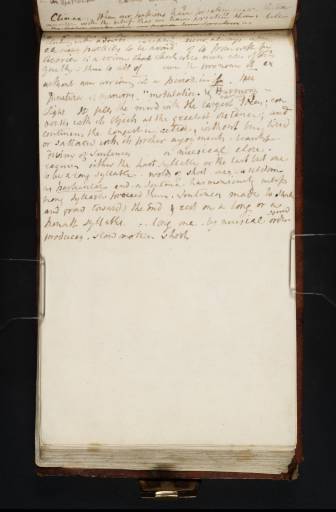A 5 rule for the strength of adverbs is avoid con|cluding with adverbs excepting, never, always | all particles to be avoid[ed] of to from with by | avarice is a crime [that deleted] which wise men are often | guilty than to add of | even the pronoun it ex | without ever arriving at a period in it. See | Junctura et numerous “modulation & Harmony – | Our sight it fills the mind with the largest ideas; con|verses with its objects at the greatest distance; and | continues the longest in action, without being tired | or satiated with its proper enjoyments. Beautiful | division of sentences a musical close | requires either the last syllable or the last but one | to be a long syllable. Words of short ones seldom | as particular and a sentence harmonious unless | long syllables proceed them. Sentences made to swell | and grow towards the End & rest either on a long or a | penult[imate] syllable ... long one, by musical sound orders | produces slow motion short
With other notes on grammar and usage in written and spoken English, this passage is based on Hugh Blair’s canonical
Lectures on Rhetoric and Belles-Lettres (1783 and subsequent editions). It conflates, in very garbled form, sections in Lecture 12, on ‘Structure of Sentences’, and Lecture XIII, on ‘Structure of Sentences – Harmony’. Wilton, who ascribes Turner’s notes to the
Cockermouth sketchbook (see above), observes that Turner’s ‘summaries of Blair’s arguments ... indicate more than a casual examination of Blair’s highly intelligent and wide-ranging book,’ the first volume of which dealt with linguistic taste, history and style and the second with public speaking.
1 However, Turner’s notes here are so abbreviated, to say the least, that they make little sense; for example, Blair’s rule cited at the beginning is for the ‘strength of sentences’ not adverbs.
Much of Blair’s advice, and indeed whole passages of his original text, were incorporated by the American grammarian Lindley Murray whose An English Grammar: Comprehending the Principles and Rules of the Language Illustrated by Appropriate Exercises (1795 and subsequent editions, most recently York 1808) became at least as famous. Perhaps Turner also used Murray’s book. He was now preparing for his lectures as Professor of Perspective at the Royal Academy, and, conscious of his deficiencies as writer and speaker, must have made his notes more in hope than expectation; his lectures, when eventually given from 1811, were famously incoherent. Anthony Bailey remarks: ‘Poor Turner! He took this to heart, enough so as to write it down, and it didn’t do him much good.’
David Blayney Brown
July 2010

